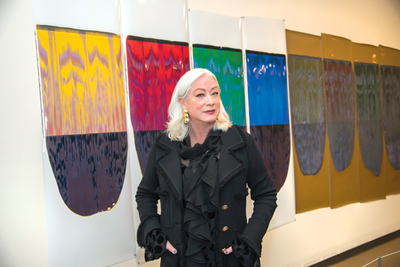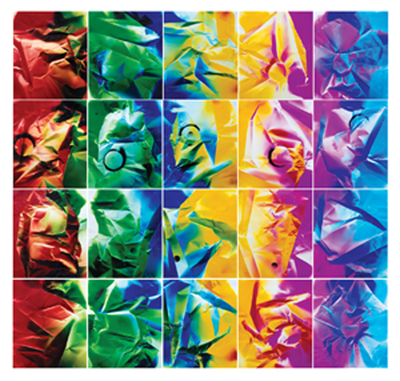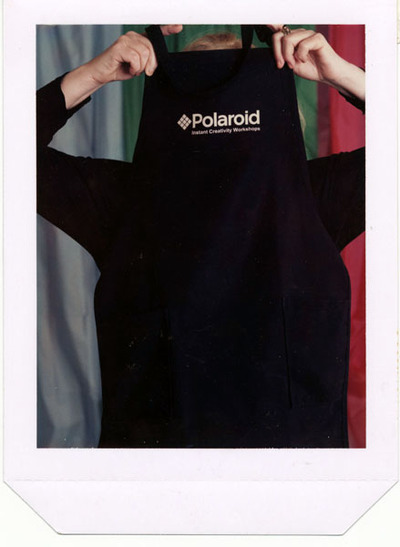Ellen Carey
Ellen Carey at the opening of A Matter of Memory: The Photographic Object in the Digital Age at the George Eastman Museum. Photo: Margaret Fox.
The tall photographer, bundled in a black coat, opened the studio door on an overcast morning in a gritty part of the city and suddenly a kaleidoscopic grid of color and shadow, a swirling jewel-toned river, composed of 16 two-foot sections, lit the air. Dings and Shadows is what Ellen Carey calls this color photogram, soaring eight feet onto a white wall in her Hartford, CT, loft space, a former typewriter factory occupied by artists and entrepreneurs.
“I’m very interested in undermining and renegotiating things that are in photography,” the silver-haired Carey said, waving her hand over an emerald green fold in the delicate paper. Carey’s handmade “dings” are purposely created to capture the color shadows from different light sources—a practice she terms “struck by light.” Photographers traditionally regard dings as flaws or defects. But Carey is not about tradition.
“I took the ding and made it my shadowcatcher,” Carey continued, seeming to speak in code. “This is avant-garde work; it is my contribution to the field.” In Dings and Shadows, each ding creates a shadowy outline. “Catching a shadow,” Carey’s phrase, refers to the dawn of the medium as a phenomenon of chemistry and light, beginning with William Henry Fox Talbot’s photograms—photographs made with lightsensitive paper instead of a camera, and using salt, silver or other materials to block the light, creating a shadow.
Ellen Carey, Dings & Shadows, 2014, color photograms, unique, 20 total C-Prints, 24 x 20″ (each); 8 x 8’4″ (all). Photo: Ethan Boisvert (NY). Courtesy of the artist, Patrick Planeta (Boston, MA), Jayne H. Baum (New York, NY), M+B (Los Angeles, CA), Yossi Milo (New York, NY).
Carey pays homage to this shadow embedded into photography’s history as she develops new paradigms, such as the color photogram. Carey, who stopped using a camera when she embraced total abstraction—“lensless photography” is her preferred term—creates photograms in total darkness. She has replaced sight with touch and sound, as she manipulates extremely lightsensitive paper that she has placed beneath a color enlarger (a light source and a lens). In total darkness, she very quickly manages the interplay between color and shadow, so the final result is an abstract composition embracing a balance between new forms and colored light. “Each piece is equal parts preplanning and serendipity,” she said, shaking her head. “For every image hung as part of a grid, I make five.”
While the gemstone-like photograms may be her most accessible works, Carey speaks of her large, abstract Pulls, which she discovered in 1996, as experiments in abstraction and minimalism, emphasizing process as subject. The positive and negative prints are created on the large-format Polaroid 20 x 24 (circa 1980), one of five in the world and used by artists and photographers such as Andy Warhol, Chuck Close, William Wegman and Elsa Dorfman. Carey is the only Polaroid artist to exhibit the negatives as well as the positives.
Her term “pull,” followed by her “rollback,” where she rolls the positive side back into the camera for additional exposures, introduced the parabola to the medium. This black conical loop has become Carey’s iconic signature. It is both abstract and minimal; it is also simultaneously process and image. With Carey’s Pulls, Polaroid and their instant technology—an American invention—meets the creative imagination of this very American abstract artist.
Ellen Carey, Self-Portrait as a Polaroid Pull (1 of 4), 2004, Polacolor ER Print, 4 x 3″. Courtesy of the artist, Patrick Planeta (Boston, MA), Jayne H. Baum (New York, NY), M+B (Los Angeles, CA), Yossi Milo (New York, NY).
Installed in museums and galleries as pairs, the pull and the rollback, these twinned, six and a half foot or larger works, resembling Japanese scrolls, present both the side exposed to light and the negative or shadow side, dualities present in Carey’s lifelong quest for the truth of our fragile lives. Her rigorous aesthetic asks that we face the thin line separating being and not being; the brief tenure in light and shadow we inevitably cast.
Like conceptualist Sol LeWitt, Carey’s friend from the late 1980s and 1990s when they exhibited simultaneously at Hartford’s Wadsworth Atheneum, her creative arc as a photographer gradually evolved into full-out color. Carey was in graduate school at the State University of New York just as its flagship Buffalo campus was exploding with mid-1970s collaborative counterculture and feminist energy. When the Polaroid Corporation began sponsoring artists interested in furthering the potential of its “instant film” technology, Carey was among the first.
Interest in non-narrative film and installation art was booming; so was performance and the use of the body in photography. Carey’s crowd included Robert Longo and Cindy Sherman. With others, these edgy Buffalo artists, pushing each other, finding their individual voices, gathered around Hallwalls, a legendary artistrun gallery. There was also CEPA, the Center for Exploratory and Perceptual Arts, focused on photography. CEPA gave Carey her first solo show and also inaugurated a Photo Bus Show series, bringing art to Buffalo’s public buses.
Carey and Sherman were paired for the bus show, Carey hanging self-portraits, including one created with a light pen, a technique used by Man Ray, whose Surrealist images Carey, a revered member of the art faculty at the Hartford Art School of the University of Hartford, studies with a scholar’s passion.
Between Carey’s early experimental self-portraits and the abstract photograms and Pulls came an installation from her Stopping Down series. These self-portraits, done in the early 2000s, are a summation of the artist’s creative evolution: the figurative and abstract; the dreamlike shadows and spotlights of her Surrealist self-portraits; the negative/positive inventions of her Pulls, and the colors and their shadows that animated her photograms.
Carey used a more traditional 8 x 10 Polaroid camera for Stopping Down, a photographer’s term for adjusting the camera’s lens to decrease the light striking the film. The nine images in the installation began with an overexposed, girlypink image of her face viewed frontally. She then adjusted the lens, or “stopped down,” until the final images obscure the photographer, seeming to age in real and symbolic time. “Like a candle burning out, with the final image the portrait fades to barely seen,” Carey wrote.
She repeated the process with herself in silhouette, echoing the Victorian paper cutout. Rich with visual pleasure, emotional content, technique and historical and cultural nuance, these pieces reference Carey’s early light portraits and anticipate the Pulls, where pulling film to let black dyes emerge took on symbolic importance, and her photograms, where shadow plays with color created by filtered light. The visit ends with Carey, whose first name, Ellen, is derived from the Indo-European “light” or “brightness,” speaking of imminent plans to revisit the massive Polaroid camera. A winter light strikes her black coat, casting shadow on the pavement.
Susan Rand Brown is a poet, art critic and frequent contributor to Art New England. She writes for Provincetown Arts and the Provincetown Banner.



